THE MICROCOSM: THE SMALLER IT IS, THE BETTER IT WORKS
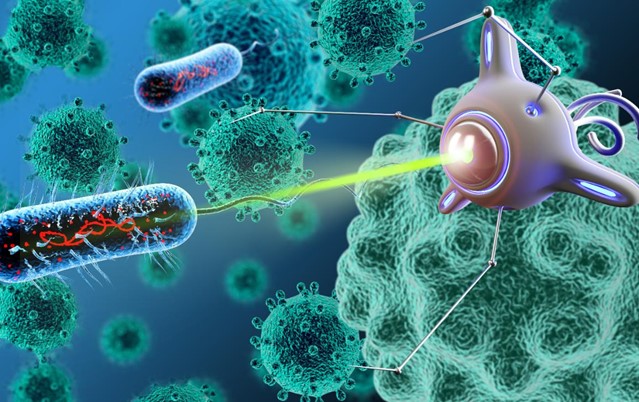
Nature surrounds us, both as macrocosm and microcosm. The macrocosm consists of objects that are proportionate to man and perceptible to the senses, such as animals, plants and various physical bodies. The microcosm, on the other hand, is a collection of extremely small objects such as molecules, atoms and elementary particles. These two ‘worlds’ have their own rules, but are closely linked[1] . In its quest for knowledge, mankind has come to master even the smallest particle system of all, namely nanotechnology. Nanotechnology (from the ancient Greek ‘nanos’ – nano) means one billionth of a part (1 nm = 10-9 m), a key concept at the beginning of the 21st century, a symbol of the scientific and technological revolution and a logical step in the development of all branches of higher science.
As early as 400 BC, the Greek philosopher Democritus first used the term ‘atom’ to describe the smallest particle of matter[2] . More than 2000 years later, Isaac Newton proposed the possibility of studying objects at the atomic level, as described in his work ‘Opticks’, published in 1704. In the book, Newton expressed the hope that the microscopes of the future would one day be able to investigate the ‘secrets of corpuscles’[3] . Albert Einstein was the first scientist to use nanometre measurements. In 1905, he wrote in his scientific articles that the size of a sugar molecule is about 1 nanometre[4] .
Without technical tools, however, nanotechnology cannot be developed. Thus, the creation of the first transmission electron microscope in 1932 and the scanning electron microscope in 1938 were important steps in forming the technological basis for the production and application of nanostructures and nanostructured materials[5] . The next major leap in technology was the development of the scanning tunnelling microscope in 1981, which earned its creators the Nobel Prize in Physics, and its successor (1986), which developed the atomic force microscope[6] .
In 1959, American physicist and Nobel Prize winner Richard Phillips Feynman first mentioned the techniques that would later be called nanotechnology[7] . Feynman considered the possibility of creating nanoscale parts and devices by means of ‘atomic’ assembly, piece by piece. The scientist states: ‘For now, we are forced to use the atomic structures that nature offers us’. He added: ‘But in principle, a physicist could synthesise any substance according to a certain chemical formula’[8] . If only he had an instrument that could sufficiently enlarge the ‘corpuscles’ and thus transport them from the microcosm to the macrocosm in which we perceive reality.
The term ‘nanotechnology’ was first coined by Norio Taniguchi at the 1974 International Conference on Industrial Engineering in Tokyo. He coined the term for the manufacture of products with dimensions of a few nanometres and also used it to describe the processing of materials with nanometric precision[9] .
Thus, a new field of science and technology has taken shape: nanotechnology. It is an interdisciplinary field of basic and applied science and technology, dealing with a combination of theoretical foundations, practical methods of research, analysis and synthesis, as well as methods of production and application of materials, devices and technical systems, the functioning of which is determined by nanostructure, i.e. ordered fragments between 1 and 100 nanometres in size[10] . Put simply, nanotechnology involves the manipulation of materials and devices so small that they cannot be perceived except with special instruments. For example, the size of most atoms is between 0.1 and 0.2 nm, the width of a DNA molecule is about 2 nm. In comparison, the typical size of a blood cell (about 7500 nm) or that of a human hair (80,000 nm) seems enormous[11] .
Very small particles acquire specific properties at the nanoscale, as the surface-to-volume ratio increases with decreasing size. Therefore, nanoparticles react much more easily in chemical reactions and exhibit more pronounced quantum physics effects. Quantum effects can influence the optical, electrical or magnetic properties of materials in unpredictable ways[12] .
Nanotechnology in our midst
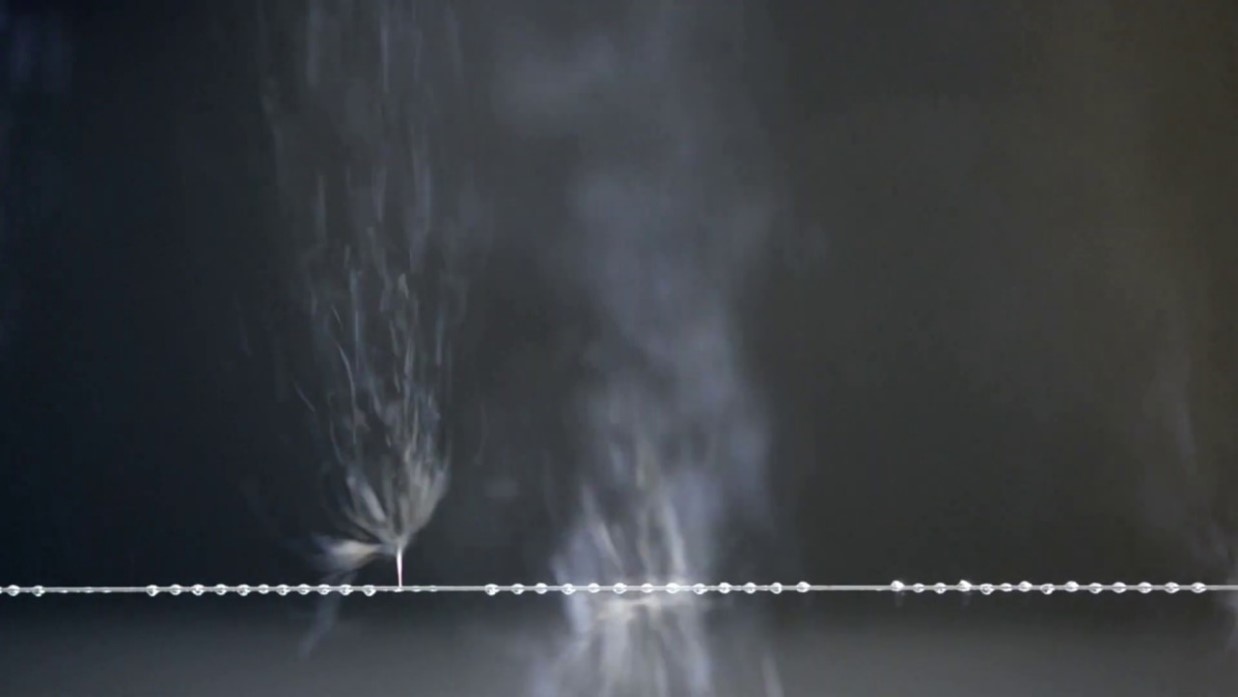
The ‘spinning’ process of nanofibres[13]
Many of us use advances in nanotechnology on a daily basis without realising it. Modern electronics has already gone from ‘micro’ to ‘nano’ and the transistors produced today – the basis of all chips – are in the 90 nm range and will get smaller and smaller[14] . The plaster we use to cover small skin wounds is covered with a thin layer of nano-silver that helps the wound heal more quickly. Toothpaste manufacturers are increasingly using mineral nanoparticles of calcium hydroxyapatite to fill enamel micro-fractures and protect teeth from caries[15] .
One of the best known and most successful nanotechnology projects is Nanospider. This is an electrostatic spinning technology used to create nanofibres. It was developed in the early 2000s by scientists from the Czech Republic and allows nanofibres to be created from various materials, such as polymers, ceramics and metals. The process of creating nanofibres with ‘Nanospider’ technology is based on electrostatic force and enables the spinning of a thin layer of polymer solution on the spinning electrode. In other words, under the influence of a strong electric field, the polymer ‘adheres’ in a thin layer to the electrode wire, thus forming a nanofibre. This process creates nanofibres with diameters ranging from a few nanometres to several micrometres.
Nanofibres created with the help of Nanospider technology can be used in various fields, such as medicine, electronics, the textile industry and others. For example, they can be used to create air and water filters, biomedical materials, lithium-ion batteries and textiles with improved breathability and water repellency[16] . Nanotechnology holds great promise for solar energy, as it makes solar panels more efficient and less expensive. The creation of nanoparticle thin films makes it possible to produce more flexible and lightweight solar panels that can be used in a wide range of applications. Photovoltaic cells can be deposited on any surface, including flexible materials such as plastic, making it possible to produce flexible and lightweight solar panels that can be mounted on a variety of surfaces. The material is 100 times lighter than conventional solar panels, but can generate 18 times more energy[17] .
The nano-threat
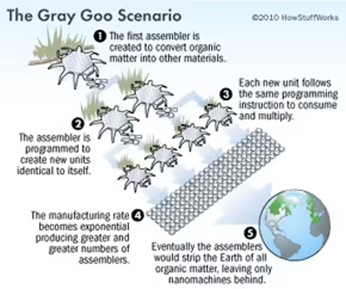
Grey slime’ scenario[18]
The idea of imitating nature to solve complex problems is realised in all fields of science and technology, and nanotechnology is no exception. One of the important goals of nanotechnology is to create a nanorobot, an assembler capable of ‘building’ various human-defined objects from atoms, and to create a replicator, a structure capable of reproducing itself from the same atoms – in other words, ‘multiplying’ (replicating) itself. Nature uses replicators everywhere, both in cellular machinery and in the reproduction of living organisms[19] .
The foundation of the theory of self-replicating structures is by John von Neumann, and was written in 1940. Based on his model, it is possible to imagine a replicator as a ‘builder’; when a third replicator is produced by two other replicators, the replication process is twice as fast and the number of replicators increases exponentially. With the help of replicators, therefore, several micrometer-sized robots can transform into one orbital station in a relatively short time interval[20] . The theory of self-replicating nanorobots has given rise to the hypothetical ‘grey goo’ global disaster scenario, in which uncontrollable self-replicating machines consume all of the Earth’s biomass. The term has become fertile ground for science fiction and the popular press[21] .
Kim Eric Drexler, a pioneer of molecular nanotechnology, first coined the term in his 1985 book “Creation Machines”, in which he describes nanomachines that can only function if they have special raw materials: “The first replicator assembles its copy in a thousand seconds; two replicators assemble two more in the next thousand seconds; four assemble four more and eight assemble eight more. After ten hours they are no longer thirty-six, but over 68 billion. In less than a day they will have gained a tonne in weight, in less than two days they will weigh more than the Earth, in another four hours their weight will exceed the mass of the Sun and all the planets combined – unless the available chemical matter is exhausted first“[22] .
Although in 2015, scientists succeeded in creating a self-replicating DNA molecule capable of producing copies of itself in a special environment[23] , these technologies are still at an early stage of research and development and have certain limitations and disadvantages. For instance, they are inefficient or unstable under real-life conditions. According to many scientists, the self-replication process is very difficult to implement, even if it does not contradict any physical laws, and modern nanotechnology is still far from self-replication. And ‘unstoppable’ self-replicating nanorobots are even more difficult to create[24] . But not impossible…
Where does nanochemistry stand?
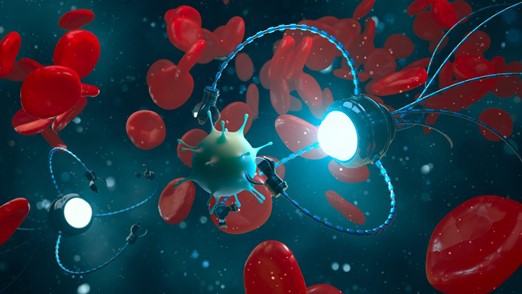
3D illustration of a nanorobot targeting a malignant cell[25]
Nanotechnology affects virtually all branches of science, and chemistry is at the forefront. Chemical properties and reactivity change considerably depending on the size of the substance. This creates new perspectives, particularly for the development of new drugs and their delivery systems[26] .
This field of medicine promises new insights into genetic codes that could be of interest for diagnostics and therapy; nanorobots operating inside the body could improve the efficiency of medical treatment; new methods of drug delivery and distribution; development of more robust and non-rejectionable artificial tissues and organs in the design of prostheses and implants; sensor-based systems could take preventive medicine to a new level[27] . Moreover, nanotechnology looks particularly promising when it comes to more reliable methods of cancer treatment in terms of efficacy and safety.
One of the most common nanomedical techniques currently used in clinical oncology is nanoformulated chemotherapy: protein or lipid nanoparticles deliver chemotherapeutic agents directly to malignant cells. Such drugs have better pharmacological parameters and reduced toxicity compared to standard ‘chemistry’. In this way, a balance between efficacy and toxicity of cancer therapies can be achieved[28] .
One of the main advantages of nanomaterials is their ability to readily interact with the human immune system. Nanoparticles can carry different antigens, or a combination of them, which significantly increases the effectiveness of treatment[29] . However, despite the promise of this field of research, there are few nanomedicines that successfully use nanotechnology in this way. With each new use, the problem is the difficulty of determining the correct ratio or combination of nanoparticles with the specific drug of interest[30] . With the great promise and growing interest in nanoparticle-based drugs, great attention needs to be paid to studying their pharmacokinetics and pharmacodynamics in order to optimise drug delivery to the target site and minimise side effects, as nanoparticles aim to achieve cumulative effects, a long-lasting action with minimal excretion from the body[31] .
Over the past decade, imaging has revolutionised the field of diagnosis, with techniques such as MRI and computed tomography producing impressive results. Nanotechnology offers tools for in vitro and in vivo diagnostics (artificial and on living cells, respectively) that are far superior to other modern equipment in terms of precision and sensitivity[32] . Nanotechnology is poised to take diagnostics to a whole new level, making cellular and possibly sub-cellular diagnostics widely available, enabling doctors to detect diseases as quickly as possible[33] .
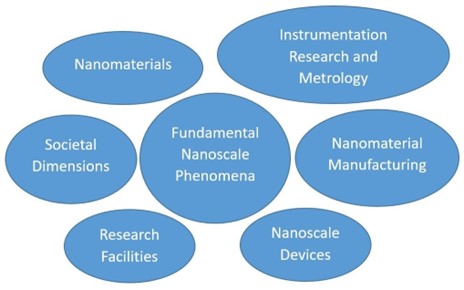
The seven key areas of the US Department of Defence nanotechnology programme[34]
Nanofibres have applications ranging from dressings to transplant surgery. Scientists are creating intelligent wound dressings that incorporate nanofibres to release drugs, stimulate coagulation and detect inflammation using nanosensors[35] . And in tissue engineering, nanomaterials can be used to create tissues whose function and structure are similar to those of the organism[36] . Experts predict that the nanomedicine market will reach USD 433.9 billion as early as 2027. Developments are taking place in many fields. However, every medical innovation requires a long and expensive path from invention to clinical trial.
Nanomedicine has the potential to improve existing drugs and invent new ones. However, nanomedicine products need further testing and research to understand how they interact with other biomolecules in the body and what biological effects this interaction may have in the long term[37] . Moreover, the probable efficacy of nanotherapeutic drugs and nanomedicine may be undesirable for the pharmaceutical industry. And then there is the question of the warlike use of these technologies.
A revolution in armaments is possible thanks to the ability of nanotechnology to modify the physical and chemical properties of particles, which in turn make possible high-strength, lightweight, corrosion- and heat-resistant structural materials with unique mechanical, thermal and optical properties (metals, alloys, ceramics, polymers, composites) that can take armaments to a new level. Since armour weighs on average 14-15 kg, a nanocomposite material (a combination of graphene and carbon nanotubes) will make armour 70% lighter and much stronger, able not only to protect against injuries but also to dissipate impact energy[38] . Composite nanomaterials could make it possible to design aircraft, ships, land vehicles and weapons that are lightweight, incredibly strong and extremely cheap[39] .
Unmanned drones are now commonplace and are used very actively in combat operations. With the application of nanotechnology, advances in drones could reach a whole new level. Drones the size of an insect, with a full range of surveillance and intelligence-gathering capabilities, could completely transform reconnaissance and warfare scenarios[40] . Nanoscale explosives can be used to create more powerful and effective explosives, nanosensors can be used to detect chemical, biological or radiological agents in the environment, which in turn offers an advantage in the development of more effective military strategies.
Warships, satellites, energy collection and storage, cyber security, invisibility of radar and sonar: nanotechnology could revolutionise every aspect of defence[41] . However, the development of nanotechnology in the defence industry entails considerable risks. Due to the highly reactive nature of nanoparticles, the consequences of their interaction with biological systems, ranging from their effects on the human body through inhalation or dermal absorption to their impact on the environment, are very difficult to predict. In the context of armaments, we are not dealing with harmless, non-harmful substances[42] .
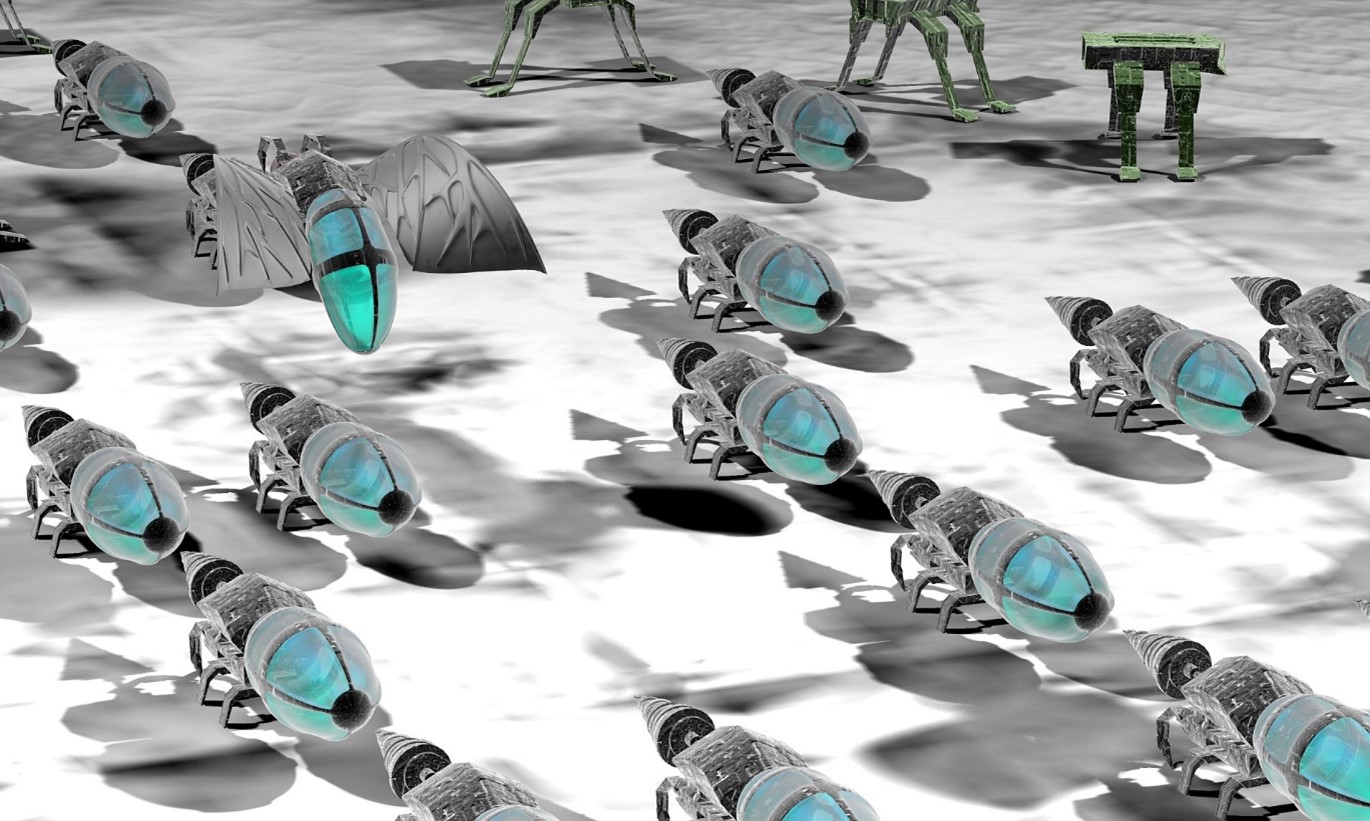
Military aircraft the size of an insect are about to revolutionise the war industry[43]
On the contrary, the use of nanotechnology in the security industry could play a very positive role, such as the use of nanosensors to detect drugs or explosives at airports, or nanomaterials to create more effective and durable equipment for police forces. But if we consider the issue in the context of the use of nanotechnology in modern weapons, the ethical problem becomes acute: there is a great risk that the use of nanotechnology advances in weapons development could target certain ethnic or genetic groups, effectively leading to the extermination of a segment of the population[44] . In the context of modern technology, the arms race can take on a completely different aspect: the more dangerous is not the ever bigger, but the ever more ‘nano’.
Nano-GMO?
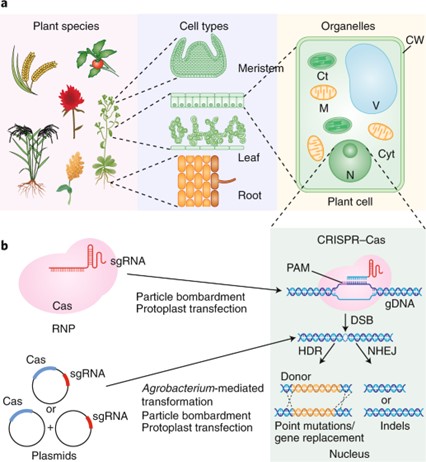
Outline of nanomaterials developed for plant biotechnology and genetic engineering[45]
The agricultural sector provides food for a growing population and supplies raw materials for the food industry. To cope with this task – taking into account different climatic conditions, varying soil fertility, pests and plant diseases, and also to produce more with less – agriculture has long been using genetically modified organisms (GMOs), fertilisers, pesticides, et cetera. Rapid population growth poses a challenge to food security and requires efficient methods of crop improvement. In recent years, nanotechnology has been the focus of attention as it can be applied at various stages of agriculture, from sowing to plant growth, storage and transport of agricultural products[46] .
Nanofertilisers, nanoherbicides (chemicals used to kill vegetation), nanofungicides (chemicals used to control fungal diseases in plants), nanobiosensors, nano-sized genetic vectors and nano-composites for packaging are new applications of nanotechnology in crop improvement. They can enable better distribution of nutrients to the plant’s target area and the unique properties of nanoparticles can extend the effects of pesticides and fertilisers, significantly improving the control of crop diseases and pests. Biosensors can serve to create high-tech farms, taking agriculture to a new technological level[47] .
Conventional plant genetic engineering methods mainly transport DNA into the nucleus, where it is integrated into the genome, resulting in the migration of genes from transgenic plants and increased plant resistance. With the recent development of nanotechnology, the use of nanoparticles for gene transfer has gained ground. The method of delivery varies from one nanoparticle to another, as each has different characteristics, such as magnetofection (transformation based on magnetic nanoparticles, i.e. the transfer of genes into the cell nucleus by applying a magnetic field[48] ), the use of carbon nanotubes which can penetrate plant cell membranes and have many advantages in the genetic engineering of plants[49] , the use of DNA nanostructures, which can enter plant cells without external assistance[50] , or for example the use of peptide nanomaterials, which restore the chemical composition of damaged plants[51] .
Nanoproducts and nanomaterials help create sustainable agricultural practices and significantly reduce the use of chemicals through more precise application. Nanotechnology is also finding its way into genetic engineering: nanoparticle-mediated genetic transformation is developing rapidly, allowing researchers to break through the cell wall barrier and penetrate the plant cell membrane, as well as reducing the drawbacks associated with current transgene delivery systems. However, many challenges remain to be overcome. The main problem with gene modification by means of nanoassemblies is the lack of stable genetic transformation and the inability to produce transgenic plants, i.e. plants in which a gene artificially transferred from other species functions successfully and reproduces itself[52] .
In addition, there is a huge lack of knowledge about the long-term effects of nanomaterials on plants, the negative effects of nanoparticles accumulating in the environment, which can cause ecotoxicity, and especially the effects on humans when products grown or modified with nanotechnology are consumed.
Nanotechnology and superpowers
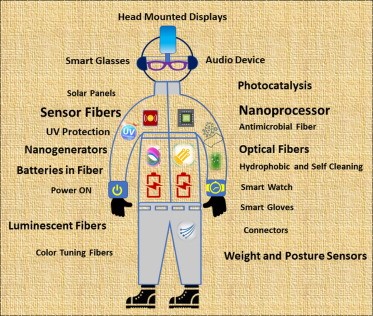
Illustration of the contours of futuristic smart clothing made of nanomaterial-treated fibres for multifunctional devices on the body[53]
The Institute for Soldier Nanotechnology (ISN)[54] has collaborated with the US Army and the Massachusetts Institute of Technology on a project to develop a combat suit for soldiers equipped with nanosensors for detecting biological and chemical agents, monitoring body states, an energy-absorbing material, protection from explosions and bullets, and an ultra-light, flexible armour[55] .
Thanks to the application of nanotechnology in the textile industry, smart textiles promise a breakthrough in terms of health and safety. In addition to the fact that textiles can already have antimicrobial, water-repellent, grease- and dirt-repellent properties and antistatic properties, with the use of conductive nanopolymers it becomes possible to endow textiles with electrical conductivity. The idea that textiles are able to store the solar, thermal and biochemical energy of the human body is becoming a reality[56] . For example, when a person walks on a hot sunny day, he or she uses biomechanical energy, solar energy, body heat and also the biochemical energy of sweat. Therefore, a hybrid generator is needed that utilises these forms of energy effectively at the same time. This integration with tissue is considered a promising research prospect for the development of a sustainable energy source for wearable electronics[57] . It will be like being a comic book superhero.
Adaptive camouflage is becoming a reality thanks to developments towards nanomaterials that exhibit chromogenicity (colour changing when exposed to external stimuli such as light (photochromia), heat (thermochromia), electric fields (electrochromia) or magnetic fields (magnetochromia)[58] . The potential applications of this technology are enormous, from the creation of light and resistant armour to the monitoring of vital signs and the development of medical solutions to quickly treat wounds on the battlefield. Although it is not yet clear how this technology will work, there is the prospect of creating a more protective and effective specialised suit, but it will still be worn by ordinary humans[59] .
The transition from ‘micro’ to ‘nano’ is no longer a quantitative transition, but a qualitative one, a leap from the manipulation of matter to the manipulation of individual atoms. Although active research into the application of nanotechnology is little more than two decades old, the evolution of the field since then is impressive. The unique behaviour of nanoparticles has led to their use in various fields. Today, literally every science has a separate field with the prefix ‘nano’: nanochemistry, nanomedicine, nanoecology, nanosafety, nanoengineering, nanobiology, et cetera.
There is no doubt that the development of nanotechnology is already changing our world and will have an even greater impact in the future, because this interdisciplinary field is a kind of bridge between physical, digital and biological systems. The use of the nanoscale allows these systems to interact with each other, to create connections.
Like any new technology, it raises many controversial issues, such as concerns about the toxicity and effects of nanomaterials on the environment and the human body; the potential impact on the global economy; safety issues; control and quality of production implementation; responsible and safe development in each sector; social and ethical issues, ranging from job losses to questions about the possibility of ‘eternal’ life; and speculation about different end-of-the-world scenarios[60] .
Nanotechnology is likely to take all areas of our lives to a qualitatively different level, and at the moment we are still unable to grasp most of the possibilities of this technology. Nor are we able to assess the risks and consequences of its large-scale invasion of our lives. But of one thing we are certain. There is no going back, humanity continues to accelerate.
USA023
[1] https://ashgabat.in/2021/09/20/istoriya-razvitiya-nanotehnologii/
[2] https://www.timetoast.com/timelines/32beef89-1a4c-4333-bbe4-d8312f6370ff
[3] https://dic.academic.ru/dic.nsf/ruwiki/1054838
[4] https://ashgabat.in/2021/09/20/istoriya-razvitiya-nanotehnologii/
[5] http://innosfera.by/node/340
[6] http://innosfera.by/node/340
[7] https://dic.academic.ru/dic.nsf/ruwiki/1054838
[8] http://innosfera.by/node/340
[9] https://www.timetoast.com/timelines/02b4ede2-7055-43dc-9d54-0f7f6c646121
[10] https://dic.academic.ru/dic.nsf/ruwiki/1054838
[11] https://newizv.ru/news/2008-01-29/chto-takoe-nanotehnologii-prosto-o-slozhnom-81165
[12] https://newizv.ru/news/2008-01-29/chto-takoe-nanotehnologii-prosto-o-slozhnom-81165
[13] https://labsarena.com/product/nanospider/
[14] https://www.nkj.ru/archive/articles/1239/
[15] https://facepla.net/the-news/tech-news-mnu/3031-nano-at-home.html
[17] https://hightech.fm/2022/12/10/ultrathin-solar-cell
[18] https://science.howstuffworks.com/gray-goo.htm
[19] https://www.nanonewsnet.ru/articles/2007/nanoreplikatory
[20] https://www.nanonewsnet.ru/articles/2007/nanoreplikatory
[21] https://ateist66.livejournal.com/376009.html
[22] https://eee.gubkin.ru/LECTURES_RF_files/%C4%D0%C5%CA%D1%CB%C5%D0_%CC%C0%D8%C8%CD%DB_%D1%CE%C7%C4%C0%CD%C8%DF.pdf
[23] https://www.nature.com/articles/nnano.2015.87
[24] https://medium.com/predict/the-gray-goo-apocalypse-nanobots-go-out-of-control-212b3b22658c
[25] https://axendia.com/blog/2020/09/03/smaller-is-better-how-nanotechnology-will-change-the-future-of-medicine/
[26] http://www.unn.ru/pages/e-library/methodmaterial/files/Knyazev_Kuznetsova.pdf
[27] http://www.unn.ru/pages/e-library/methodmaterial/files/Knyazev_Kuznetsova.pdf
[28] https://thepharma.media/medicine/29741-nanomedicina-v-onkologii-krosecnye-casticy-kolossalnyi-potencial-06072022
[29] https://thepharma.media/medicine/29741-nanomedicina-v-onkologii-krosecnye-casticy-kolossalnyi-potencial-06072022
[30] https://www.medicaldevice-network.com/comment/nanotechnology-medicine-technology/
[31] https://www.msdmanuals.com/ru/%D0%BF%D1%80%D0%BE%D1%84%D0%B5%D1%81%D1%81%D0%B8%D0%BE%D0%BD%D0%B0%D0%BB%D1%8C%D0%BD%D1%8B%D0%B9/%D0%BA%D0%BB%D0%B8%D0%BD%D0%B8%D1%87%D0%B5%D1%81%D0%BA%D0%B0%D1%8F-%D1%84%D0%B0%D1%80%D0%BC%D0%B0%D0%BA%D0%BE%D0%BB%D0%BE%D0%B3%D0%B8%D1%8F/%D1%84%D0%B0%D1%80%D0%BC%D0%B0%D0%BA%D0%BE%D0%BA%D0%B8%D0%BD%D0%B5%D1%82%D0%B8%D0%BA%D0%B0/%D0%BD%D0%B0%D0%BD%D0%BE%D0%BC%D0%B5%D0%B4%D0%B8%D1%86%D0%B8%D0%BD%D0%B0
[32] https://www.sciencedirect.com/topics/medicine-and-dentistry/in-vivo-diagnostics
[33] https://www.sciencedirect.com/science/article/pii/S2414644723000337#bib0042
[34] https://blog.nanochemigroup.cz/nanotechnology-and-the-military-how-tiny-materials-can-win-wars/
[35] https://www.sciencedirect.com/topics/medicine-and-dentistry/wound-dressings
[36] https://www.sciencedirect.com/science/article/pii/S2414644723000337#sec0010
[37] https://www.gazetametro.ru/articles/buduschee-za-nanomeditsinoj-ona-pomozhet-postavit-diagnoz-esche-na-rannej-stadii-zabolevanija-21-03-2023
[38] https://www.nanowerk.com/spotlight/spotid=61331.php
[39] https://blog.nanochemigroup.cz/nanotechnology-and-the-military-how-tiny-materials-can-win-wars/
[40] https://www.nanowerk.com/spotlight/spotid=61331.php
[41] https://www.hilal.gov.pk/eng-article/detail/NjY2Mg==.html
[42] https://moderndiplomacy.eu/2023/03/13/the-ethical-implications-of-nanotechnology-in-modern-warfare-balancing-benefits-and-risks/
[43] https://www.dailymail.co.uk/sciencetech/article-4330776/Insect-size-robot-weapons-render-humanity-EXTINCT.html
[44] https://moderndiplomacy.eu/2023/03/13/the-ethical-implications-of-nanotechnology-in-modern-warfare-balancing-benefits-and-risks/
[45] https://www.nature.com/articles/s41565-021-00854-y#additional-information
[46] https://www.sciencedirect.com/science/article/abs/pii/S2214785322063283
[47] https://www.sciencedirect.com/science/article/pii/S2666154322001909
[48] https://www.nature.com/articles/3301624
[49] https://www.nature.com/articles/s41565-019-0375-4
[50] https://www.pnas.org/doi/full/10.1073/pnas.1818290116
[51] https://onlinelibrary.wiley.com/doi/10.1111/tpj.14973
[52] https://onlinelibrary.wiley.com/doi/10.1111/tpj.14973
[53] https://www.sciencedirect.com/science/article/pii/S2090123222000194#s0110
[54] https://isn.mit.edu/isn-4-sra-1-soldier-protection-battlefield-care-and-sensing
[55] https://blog.nanochemigroup.cz/developing-nanotechnology-in-the-defence-industry/
[56] https://pubs.acs.org/doi/10.1021/acs.chemrev.9b00821
[57] https://www.sciencedirect.com/science/article/pii/S2090123222000194#b1435
[58] https://www.nanowerk.com/spotlight/spotid=61331.php
[59] https://blog.polymernanocentrum.cz/nanotechnologie-a-zitrejsi-pesak/
[60] https://neftegaz.ru/tech-library/tekhnologii/141844-nanotekhnologii/




Leave a Reply